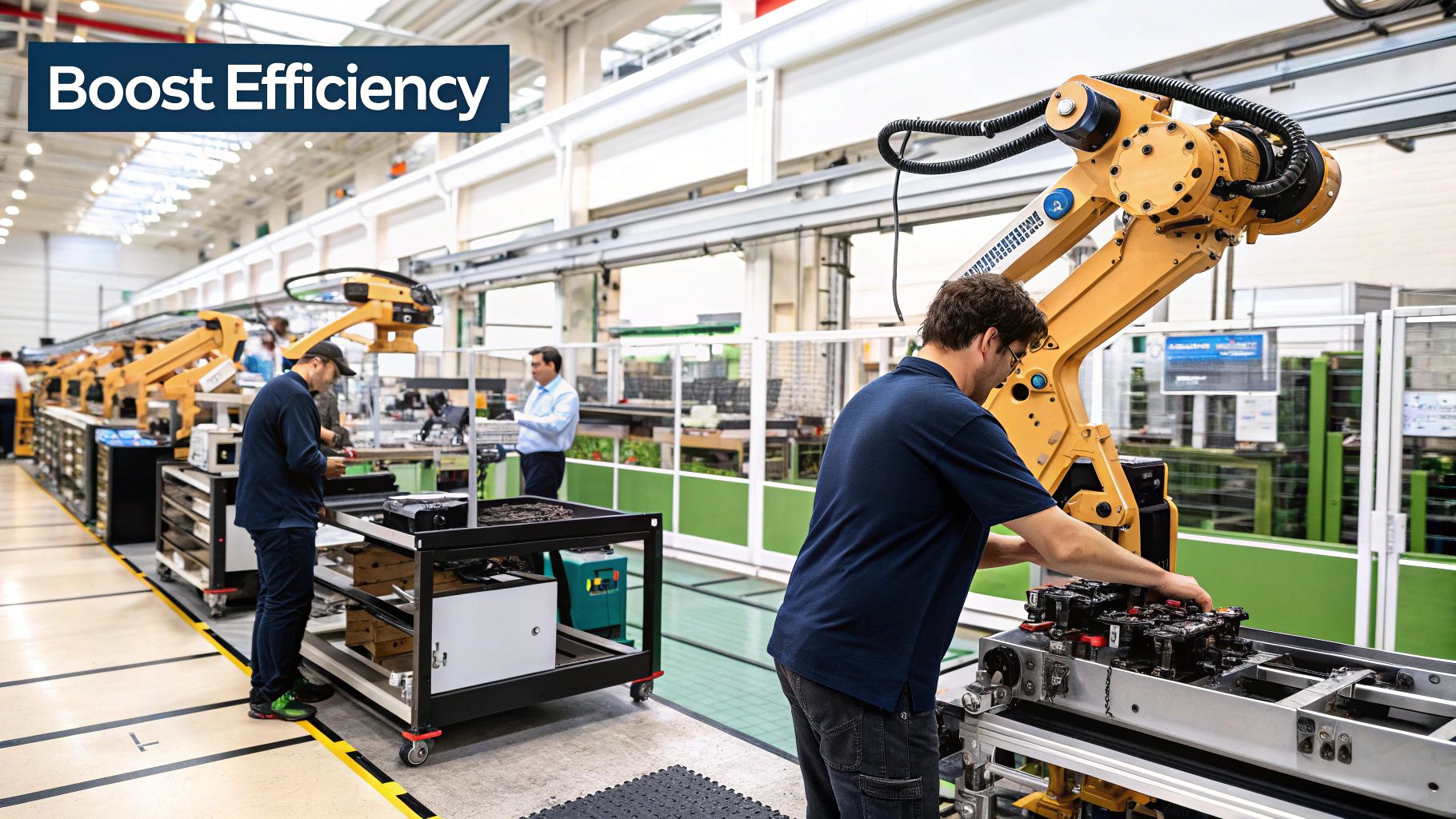Automation ROI: Your Guide to Maximizing Real Returns
- Matthew Amann
- Jun 5
- 15 min read
Understanding Automation ROI in Today's Business Reality

Automation is frequently discussed for its potential to reshape businesses. But what exactly does a successful automation Return on Investment (ROI) look like? It's about more than just cutting costs. True automation ROI encompasses a wider range of benefits, from increased efficiency and productivity to better quality and happier customers. This means businesses need to consider the long-term strategic advantages in addition to immediate cost savings.
Expanding the Definition of ROI
Many organizations make the mistake of focusing only on the initial investment and immediate cost savings when calculating automation ROI. This limited view misses the bigger picture. For example, improvements in quality control through automation can lead to fewer errors and less rework, ultimately boosting profits.
Furthermore, increased speed and efficiency translate to quicker turnaround times and improved customer satisfaction. This can cultivate customer loyalty and drive repeat business. Understanding how to measure this return is critical. Similar strategies can be used to maximize returns on your influencer marketing ROI.
This broader understanding of automation ROI is backed by industry research. Across the spectrum of business automation, the ROI benefits are not confined to cost savings and efficiency improvements. They also include enhanced customer and employee satisfaction. A McKinsey survey revealed that two-thirds of respondents reported improvements in quality control, customer satisfaction, and employee experience, along with reduced operating costs, thanks to automation.
In addition, nearly 9 in 10 employees trust automation solutions to deliver accurate results. This highlights the increasing confidence in automated processes and their positive impact on various business aspects. More detailed statistics on automation can be found here.
Beyond Cost Savings: The Intangible Benefits
While cost reduction is a key driver for automation, the intangible benefits often play an even larger role in the overall ROI. These benefits might be more difficult to quantify, but they are essential for long-term success.
Improved Employee Morale: Automating repetitive, mundane tasks frees up employees to focus on more stimulating and challenging work. This can lead to higher job satisfaction and lower employee turnover.
Enhanced Customer Experience: Automation can enhance customer service by improving response times, personalizing interactions, and providing smoother, more efficient experiences. This ultimately strengthens customer relationships.
Increased Agility: Automated processes empower businesses to respond quickly to changing market conditions and evolving customer needs. This adaptability provides a significant competitive advantage.
These less tangible benefits, coupled with the more easily measurable cost savings, create a strong argument for automation. By understanding the full range of potential returns, businesses can make strategic decisions about where to invest in automation and how best to measure its success.
Calculating Automation ROI That Finance Teams Trust

The infographic above provides a clear example of automation ROI, contrasting initial costs with the annual labor savings generated. A $20,000 investment in automation can yield $50,000 in annual labor savings, achieving a 150% ROI in just one year. This highlights the substantial return potential of automation projects. However, accurately determining ROI requires a more nuanced approach. Finance teams require a detailed analysis that considers all costs and benefits, encompassing both hard (easily quantifiable) and soft (less tangible) factors.
Quantifying the Hard Benefits
Hard benefits are the most straightforward to measure and frequently the most compelling for finance teams. These typically include cost reductions and efficiency gains.
Reduced Labor Costs: Automation decreases the need for manual work, resulting in significant cost savings.
Increased Productivity: Automated systems can operate continuously, completing tasks more quickly and efficiently than human workers.
Lower Error Rates: Automation minimizes errors, leading to less rework, reduced waste, and lower associated costs.
Reduced Processing Time: Automation streamlines workflows, shortening processing times for faster turnaround and improved operational efficiency.
Automating invoice processing, for instance, eliminates manual data entry. This reduces errors and allows staff to focus on more strategic activities. For more insights into automation, you might find this helpful: How to master field service automation. These quantifiable improvements directly contribute to a healthier bottom line.
Capturing the Soft Benefits
While more challenging to quantify, soft benefits are essential for a comprehensive ROI assessment. These benefits contribute to long-term value creation and should not be disregarded.
Improved Employee Satisfaction: Automating repetitive tasks improves morale by allowing employees to engage in more stimulating and meaningful work.
Enhanced Customer Experience: Automation enables faster response times and personalized interactions, boosting customer satisfaction and loyalty.
Increased Compliance: Automated processes help ensure adherence to regulatory requirements, mitigating the risk of penalties and legal issues.
Better Decision-Making: Automation supports data collection and analysis, providing valuable insights for more informed decision-making.
Though not as easily visible in financial reports, these benefits can significantly impact the overall success of automation initiatives.
Building a Credible ROI Model
A trustworthy automation ROI model must be realistic and transparent to build confidence with finance teams. This involves meticulous planning, execution, and monitoring.
Establishing Baseline Metrics: Defining clear baseline metrics before implementing automation allows for accurate progress measurement.
Accounting for All Costs: Incorporate all implementation costs, including training, ongoing maintenance, and potential software licensing fees.
Setting Realistic Timelines: Avoid unrealistic ROI projections. Recognize that certain benefits might take time to fully realize.
Tracking Progress and Adjusting: Regularly monitor progress against the established metrics and refine the model as necessary.
To provide further clarity on ROI calculation methods, the following table offers a helpful comparison framework.
To help you choose the right ROI calculation method for your automation project, we've compiled a comparison of various approaches:
Automation ROI Calculation Framework
Calculation Method | Best For | Timeframe | Accuracy Level | Implementation Difficulty |
|---|---|---|---|---|
Simple Payback Period | Quick estimates | Short-term | Low | Easy |
Discounted Cash Flow (DCF) | Long-term investments | Long-term | High | Complex |
Internal Rate of Return (IRR) | Comparing projects | Long-term | Medium | Medium |
Return on Investment (ROI) | Overall profitability | Medium-term | Medium | Medium |
This table provides a quick overview of different methods, allowing you to select the most suitable one based on your specific needs and the complexity of your automation project. Consider factors like the timeframe of your project and the level of accuracy required when making your selection.
By incorporating both hard and soft benefits, acknowledging all associated costs, and implementing a robust tracking mechanism, you can develop an automation ROI calculation that instills confidence in finance teams and propels successful automation projects.
RPA ROI: The Financial Reality Behind The Hype

Robotic Process Automation (RPA) offers businesses the potential for significant returns. However, achieving these returns requires careful planning and execution. This section explores the tangible financial benefits of RPA, comparing the costs of human employees and software robots. We'll also examine why some RPA projects succeed while others fall short, offering insights into selecting the right processes for automation. Understanding these factors is essential for a positive automation ROI.
Human vs. Robot: A Cost Comparison
One of the strongest arguments for RPA is its potential for substantial cost savings. RPA software robots often execute tasks at a fraction of the cost of human workers. This cost advantage comes from several factors, including fewer errors, increased speed, and 24/7 availability.
For instance, a robot can process invoices much faster and more accurately than a person, reducing processing time and eliminating costly mistakes. RPA excels at handling high-volume, repetitive tasks, freeing up human employees for more strategic, value-added work. This shift not only improves efficiency but also boosts employee morale.
This enhanced efficiency translates directly to a healthier bottom line. Return on investment (ROI) from automation has been a key driver of its adoption across various industries. According to Flobotics, the expected ROI from RPA can range from 30% to 200% in the first year, with a potential long-term ROI of up to 300%.
This substantial return is attributed to RPA software robots being significantly more cost-effective than human workers. They are estimated to cost one-third of an offshore full-time employee and one-fifth of an onshore worker. For more detailed statistics, see RPA Statistics. When calculating ROI, consider the cost savings from reduced storage and faster data transfer. Learn more about data compression here.
Identifying Automation Candidates: Picking the Right Processes
Not every process is suitable for RPA. Selecting the wrong automation candidates can lead to a disappointing ROI and wasted resources. Ideal processes for RPA are:
High-Volume: Frequently performed processes offer greater cost-saving potential.
Repetitive: Tasks that follow a defined set of rules are well-suited for automation.
Rule-Based: Processes with clear inputs and outputs are simpler to automate.
Manual and Time-Consuming: Automating these tasks frees up employees for more strategic work.
Prone to Errors: RPA minimizes errors, improving accuracy and reducing rework.
Focusing on these criteria helps organizations pinpoint processes with the highest potential for a positive automation ROI.
Maximizing RPA ROI: Keys to Success
Successful RPA implementation requires a strategic approach. Key factors for maximizing RPA ROI include:
Clear Objectives: Define specific, measurable, achievable, relevant, and time-bound (SMART) goals.
Stakeholder Alignment: Ensure everyone understands the objectives and benefits of RPA.
Thorough Planning: A detailed implementation plan addressing all project aspects is crucial.
Ongoing Monitoring and Optimization: Continuously monitor RPA bot performance and make necessary adjustments.
Following these best practices increases the likelihood of a substantial automation ROI and builds confidence for future automation projects.
Sales Automation ROI: Converting Investment Into Revenue
Sales automation offers a compelling ROI, impacting not only cost savings but, more importantly, revenue generation. This section explores how AI-powered sales automation delivers measurable returns. We'll look at improved conversion rates, shorter sales cycles, and the development of stronger customer relationships. These relationships, in turn, build long-term value by fostering loyalty and driving repeat business. Finally, we'll examine specific metrics that sales leaders use to justify automation investments and demonstrate clear value to executive teams.
From Cost Savings to Revenue Growth
While cost reduction is a significant benefit, the true power of sales automation lies in its ability to drive revenue growth. By automating repetitive tasks, such as lead qualification and follow-up, sales teams can focus on high-value activities. These include building relationships and closing deals. For instance, automated email sequences can nurture leads by providing valuable information and guiding them through the sales funnel. Simultaneously, sales representatives can concentrate on personalized interactions with qualified prospects. This targeted approach improves conversion rates and speeds up the sales process.
You might be interested in: Top Business Automation Services To Transform Your Business
Measuring the Impact: Key Sales Metrics
Several key metrics demonstrate the ROI of sales automation:
Conversion Rate: This metric tracks how many leads convert into paying customers. Automation can boost this rate by ensuring timely and relevant communication.
Sales Cycle Length: This measures the time it takes to close a deal. Automation streamlines this process, shortening the cycle and accelerating revenue.
Customer Lifetime Value (CLTV): This calculates the total revenue generated by a customer throughout their relationship with your business. Automation helps nurture these relationships, ultimately increasing CLTV.
Deal Size: Analyzing the average value of closed deals is crucial. Automation can empower sales teams to focus on higher-value prospects, leading to larger deal sizes.
These metrics offer concrete evidence of sales automation's impact on revenue. This allows sales leaders to present a clear value proposition to executive teams.
Real-World Results: Automation in Action
Leading companies are successfully using sales automation to achieve impressive results. They're scaling their sales operations while still providing personalized customer experiences. Sales automation, particularly when integrated with AI, has demonstrated impressive ROI figures. Companies using AI in sales automation have reported a 10-20% increase in ROI. This improvement is largely attributed to the streamlining of repetitive processes. It minimizes errors and frees sales professionals for more meaningful customer interactions. Automating daily tasks saves an average of 5 hours per week for knowledge workers, allowing them to dedicate more time to closing deals and fostering customer trust. Find more detailed statistics here. These real-world results highlight how sales automation can transform sales performance and create a sustainable competitive advantage.
Avoiding Automation ROI Disasters That Kill Projects

Even with the best of intentions, automation projects can sometimes miss the mark, leading to wasted resources and diminished stakeholder confidence. Achieving a positive return on investment (ROI) from automation requires careful planning, realistic expectations, and consistent monitoring. This section explores common pitfalls that can derail automation initiatives and offers strategies to avoid these costly mistakes. We'll also examine how to manage expectations, recognize warning signs, and make informed decisions about your automation investments. You can learn more about practical automation in our article about automating inventory with Zapier.
Setting Realistic Expectations and Timelines
One of the most common reasons automation projects fail to deliver the expected ROI is unrealistic expectations. Many organizations anticipate immediate, dramatic results, overlooking the fact that automation benefits often develop gradually over time.
For example, while some cost savings might be realized quickly, achieving the full potential of process improvements can take months. That's why establishing realistic timelines and milestones is so important. This helps manage stakeholder expectations and provides a structure for tracking progress.
Recognizing Early Warning Signs
Recognizing potential issues early is key to preventing major setbacks. Being proactive can save valuable time and resources.
The following are some common warning signs that a project might be veering off track:
Scope Creep: The project expands beyond its initial objectives, leading to increased costs and complexity.
Lack of Stakeholder Buy-In: Without the full support of key stakeholders, a project may lack the resources and backing it needs to succeed.
Integration Challenges: Difficulties integrating automated systems with existing infrastructure can cause delays and budget overruns.
Poor Data Quality: Inaccurate or incomplete data can compromise the effectiveness of automation, resulting in unreliable outcomes.
Addressing these issues promptly can prevent them from becoming major obstacles.
The following table summarizes the key success factors and potential pitfalls to watch out for when implementing automation initiatives, along with strategies to mitigate risks and recover from setbacks.
To better understand how to navigate these challenges, let's take a closer look at what separates successful automation ROI initiatives from those that fall short. The table below provides a detailed comparison, outlining potential pitfalls and strategies for preventing and recovering from them.
Automation ROI Success Factors vs. Failure Points: A detailed comparison showing what separates successful automation ROI initiatives from failed ones.
Success Factor | Common Pitfall | Impact on ROI | Prevention Strategy | Recovery Action |
|---|---|---|---|---|
Clear Objectives | Scope Creep | Reduced ROI due to increased costs and timelines | Clearly define project scope and stick to it. Use project management software to track progress. | Re-evaluate project scope and prioritize essential features. Cut unnecessary features. |
Stakeholder Buy-in | Lack of Support | Delays and lack of resources | Secure buy-in from key stakeholders early on. Communicate project benefits clearly. | Reinforce the value proposition of the project to stakeholders. Address their concerns directly. |
Seamless Integration | Integration Challenges | Cost overruns and delays | Thoroughly test integrations before full implementation. Choose compatible systems. | Engage expert help to resolve integration issues. Consider alternative integration approaches. |
High-Quality Data | Poor Data Quality | Inaccurate results and wasted effort | Implement data quality checks and cleansing processes. Ensure data accuracy from the source. | Implement data remediation strategies. Invest in data quality tools and training. |
Realistic Timelines | Unrealistic Expectations | Disappointment and loss of trust | Set achievable timelines based on data and expert input. Communicate timelines clearly. | Adjust timelines based on actual progress. Manage stakeholder expectations proactively. |
By understanding these potential pitfalls and implementing the suggested prevention and recovery strategies, businesses can significantly improve their chances of automation success. Remember, careful planning and ongoing monitoring are critical to maximizing ROI.
Pivoting, Scaling Back, or Doubling Down
Not every automation project will yield the expected ROI. Sometimes, adjustments are necessary. It might be necessary to pivot, scale back, or even abandon a project. For example, if implementation costs are significantly higher than anticipated, scaling back the project's scope might be the best course of action.
Conversely, a pilot project demonstrating exceptional results could warrant increasing the investment. Making these decisions based on actual performance data, not just hopeful projections, is crucial for optimizing automation ROI.
Building a Culture of Continuous Improvement
Automation isn't a one-time solution. It's an ongoing process of refinement and optimization. Continuously monitoring performance, gathering feedback, and implementing necessary adjustments are crucial for sustained success. This iterative approach ensures that automation initiatives continue delivering a positive ROI and contributing to overall business goals.
By recognizing the potential pitfalls and adopting a proactive approach to risk management, organizations can considerably increase their chances of realizing their automation ROI objectives.
Building Your Winning Automation ROI Strategy
Building a successful automation ROI strategy is more than simply implementing new software. It requires a comprehensive approach aligned with your overarching business objectives. This section provides practical frameworks for prioritizing automation opportunities, crafting compelling business cases, and developing implementation plans that deliver. We’ll explore how to connect automation initiatives with business goals, establish strong governance, and foster organizational capabilities for lasting success.
Prioritizing Automation Opportunities: Picking the Right Battles
Not every process is a good candidate for automation. Some offer a significantly higher return than others. To maximize your automation ROI, prioritize strategically. Focus on processes that are:
High-volume and repetitive: These are ideal for automation, offering the greatest potential for cost savings and efficiency gains. Automating invoice processing, for example, can dramatically reduce manual work and errors.
Rule-based and predictable: Processes with clearly defined steps are simpler to automate and less likely to need complex adjustments. Data entry and report generation are good examples.
Currently manual and time-consuming: Automating these processes frees up employee time for more strategic work requiring human judgment and creativity.
Prone to errors: Automation can minimize human error, increasing accuracy and reducing the need for rework.
Prioritizing these types of processes ensures your automation efforts deliver the biggest impact.
Building a Compelling Business Case: Getting Stakeholder Buy-In
Getting approval for automation projects requires a strong business case clearly demonstrating potential ROI. Go beyond simply listing the benefits of automation; provide concrete evidence. To build a compelling case:
Quantify the benefits: Use data and metrics to demonstrate the potential cost savings, efficiency gains, and revenue growth achievable through automation. Calculate the potential time and money saved by automating a specific process.
Address potential concerns: Acknowledge any potential downsides, such as implementation costs or employee displacement, and offer solutions to mitigate these risks. This shows forethought and builds trust.
Align with business goals: Explain how the automation project supports broader business objectives like increasing revenue, improving customer satisfaction, or enhancing operational efficiency.
Present a clear roadmap: Outline the implementation plan, including timelines, milestones, and key performance indicators (KPIs). This gives stakeholders a clear understanding of the project’s trajectory.
A well-structured business case is crucial for securing buy-in and resources.
Implementing for Success: A Practical Framework
Even with a strong business case, successful implementation demands a structured approach. Consider these key steps:
Define clear objectives: Establish specific, measurable, achievable, relevant, and time-bound (SMART) goals for the project to maintain focus and enable accurate progress tracking.
Choose the right tools: Select automation tools aligned with your specific needs and integrate seamlessly with existing systems. Flow Genius offers tailored solutions using tools like Zapier, custom code, and various software integrations.
Test and refine: Thorough testing and continuous refinement are crucial for optimizing performance and ensuring the solution delivers expected results. Be prepared to adapt your strategy based on data and feedback.
Monitor and measure: Regularly track KPIs to monitor progress and identify areas for improvement. This data-driven approach helps maximize ROI.
Following this framework increases the likelihood of a successful implementation and strong ROI. Flow Genius can guide and support you throughout the process.
Building Organizational Capabilities: Sustaining Long-Term Success
Automation is not a one-time project, but an ongoing process of improvement. For sustained success, build organizational capabilities that support continuous automation. This includes:
Investing in training and development: Provide your team with the necessary skills and knowledge to manage and optimize automated processes.
Fostering a culture of innovation: Encourage experimentation and continuous improvement to identify new automation opportunities.
Establishing governance structures: Implement clear roles, responsibilities, and decision-making processes to ensure accountability and efficient project management.
By investing in these capabilities, you can create a sustainable automation strategy that delivers ongoing value and supports your long-term business goals. Flow Genius offers data advisory services to help you make data-driven decisions, transforming raw information into actionable insights.
Key Takeaways
Building a successful automation strategy depends heavily on understanding and maximizing your automation ROI. This goes beyond simply cutting costs; it's about generating tangible business value. Here are some key takeaways to guide your automation journey:
Understanding The Broader Impact of Automation
Automation ROI isn't just about saving money. It also includes improvements in quality, speed, customer satisfaction, and even employee morale. For example, automating repetitive tasks allows employees to focus on more strategic initiatives, boosting job satisfaction and productivity. This broader perspective is essential for developing a comprehensive ROI model.
Accurate ROI Calculation Is Key
Finance teams need to see hard data. Building a credible ROI model is critical. This involves:
Establishing clear baseline metrics: Measure current performance before implementing automation to accurately gauge its impact.
Accounting for all costs: Include implementation costs, training expenses, and ongoing maintenance in your calculations.
Setting realistic timelines: Acknowledge that some benefits might take time to appear. Avoid overly optimistic projections.
Tracking progress and adjusting: Regularly monitor performance and adapt your strategy as needed.
Picking The Right Processes for Automation
Not all processes are suitable for automation. Prioritize processes that are:
High-volume and repetitive: These offer the greatest potential for cost savings and efficiency gains.
Rule-based and predictable: These are simpler to automate and require less complex modifications.
Currently manual and time-consuming: Automating these tasks frees up employees for more strategic work.
Prone to errors: Automation minimizes human error, leading to improved accuracy and reduced rework.
For instance, automating invoice processing can significantly decrease manual work and errors, providing a strong potential ROI.
Sales Automation: A Direct Path to Revenue Growth
Sales automation presents a unique opportunity to directly influence revenue. Key metrics to monitor include:
Conversion Rate: The percentage of leads that convert into paying customers.
Sales Cycle Length: The time taken to close a deal.
Customer Lifetime Value (CLTV): The total revenue generated by a customer.
Deal Size: The average value of closed deals.
By concentrating on these metrics, you can showcase the tangible effect of sales automation on revenue growth. Companies using AI in sales automation have seen a 10-20% increase in ROI, largely due to streamlined processes and increased efficiency. You can learn more about this technology at Salesforce.
Avoiding Automation Pitfalls
Even well-planned automation projects can face hurdles. Keep in mind:
Unrealistic expectations: Set achievable goals and timelines.
Lack of stakeholder buy-in: Ensure support from key stakeholders from the beginning.
Integration challenges: Guarantee smooth integration with current systems.
Poor data quality: Accurate data is essential for successful automation.
By addressing these potential problems proactively, you can substantially increase your likelihood of automation success.
Ready to transform your business with intelligent automation? Flow Genius helps you achieve real ROI by eliminating manual processes and optimizing your workflows. Visit Flow Genius to learn more.